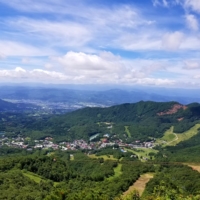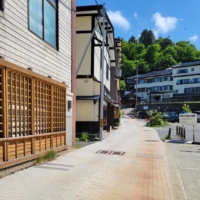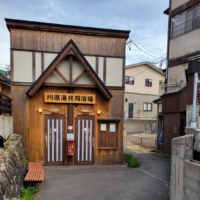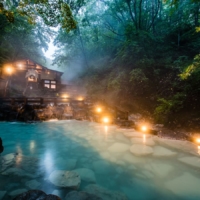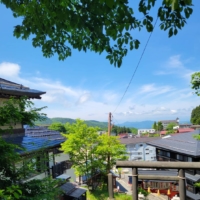Discover the Charms of Zao Onsen: A Hidden Gem in Yamagata
“Everyone looked forward to getting off of the bus and walking down the slope lined with long-established inns and souvenir shops, as the smell of the onsen drifted through the air. In summer, all of the inns had their windows thrown wide open with used bath towels hanging out to dry like noren curtains. You could catch glimpses inside the rooms from outside and listen to the gentle sound of the geisha songs and shamisen as they entertained guests.” These are the words of the late 15th generation innkeeper Yaheiji Okazaki, reminiscing on the summer atmosphere of his hometown, Zao Onsen, towards the end of the Taisho era. If you’re into winter sports in Japan, the name might sound familiar. If not, it’s a lot less likely to have crossed your radar.
I also happen to call the tranquil mountain town my home, relocating from Tokyo to Zao after marriage to the 17th generation Okazaki. It might not have been love at first sight for this big city girl, but the charms of small town life have since grown on me. As I read articles increasingly centered on the issues of over-tourism and swarms of visitors at the better known sights in Japan, I wish a little bit of that would make its way north to Zao Onsen, a town that relies heavily on snow tourism for survival, but is also an enchanting and highly underrated summer destination.
While the summer heat waves are taking over the cities, mountain towns like Zao are a welcome retreat from the relentless heat. Here, you can explore historic streets, indulge in the rejuvenating hot spring baths, savor cold soba noodles, and ride the ropeways for breathtaking views—all while the mercury stays comfortably below 30°C.
Where is Zao Onsen?
The town of Zao Onsen is located in Yamagata Prefecture in the Tohoku region of Japan. It’s easily accessible from Tokyo Station— a 2.5-hour shinkansen ride to Yamagata Station is followed by a scenic 40-minute bus journey into the mountains, a route that has been traveled for centuries. I still vividly remember my first shinkansen ride to Yamagata, where urban landscapes swiftly gave way to vast rice fields, dense forests, and towering mountains. Yamagata embodies the quintessential Japanese countryside. For Ghibli fans, you might even recognize it as the setting of the 1987 classic, Only Yesterday.
The Discovery
Like many historical towns, Zao Onsen has its own founding legend, dating back almost 2000 years to 110 AD, complete with a warrior and enemy arrows. During the reign of the 12th Emperor Keiko, Prince Yamato set out to explore the Eastern lands, along with a retainer by the name of Kibino Takayu. As they approached the present day Zao area, Takayu was struck by an enemy arrow, forcing him to seek refuge in the mountains for protection. From his elevated hiding spot, he spotted water gushing forth from the rocks below and descended as quickly as he could. He submerged his body in the steaming water and was instantly soothed, his wounds healing miraculously fast.
This led to the discovery of the powerful, healing onsen, and the area was henceforth called Takayu Onsen after the injured warrior. In fact, the town was named Takayu Onsen all the way until 1950 when Mt. Zao was listed as one of the top 100 tourist destinations in Japan and they decided to rebrand as Zao Onsen.
The Onsen
Since its ancient discovery, many have sought these renowned healing waters, claimed to alleviate a range of ailments from eczema to high blood pressure. The onsen here is the second most acidic in Japan, with a pH hovering around 1.5. In fact, when you step off the bus, the pungent smell not unlike that of rotting eggs is probably one of the first things you’ll notice, but your nose will quickly adjust.
With onsen as an obvious main attraction, you’ll find 4 day trip bath facilities, 3 public bathhouses and 3 foot baths located in the village, along with a multitude of inns and hotels that offer public and private bath experiences. The public bathhouse Kawarayu is said to have been built upon the site where Kibino Takayu first bathed. Zao Onsen also has a prized Dairotenburo— a large open air bath that can fit 200 people at once (there’s a bath for each gender).
Beyond the Onsen
Aside from soaking in the hot springs, Zao Onsen features a shrine founded in the mid 800s, a volcanic crater lake, multiple ropeways to take in the panoramic views of the mountains, and a myriad of restaurants both Japanese and Western.
It’s easy to get around the area on foot, though rental cycles are available at the bus terminal. Spending at least one night— if not more— is recommended to fully embrace the serene atmosphere of Zao. There’s no rush to get to the next sight or to catch the next train. Instead, leisurely wander the narrow streets listening to the soothing sound of the onsen streams that run along the streets and under them, dip your feet in the foot baths, then enjoy a cool drink as the sun sets in the mountains.
I find that visiting places like Zao Onsen provides an opportunity for you to slow down and savor the moment, and to be present in your surroundings. It’s simple yet somehow feels like a luxury to be able to just sit and be. But that’s exactly the town atmosphere that Yaheiji Okazaki describes in his writings, and one that still lives on in Zao Onsen today.
Stay tuned as I take you along to some of the best spots in this hidden gem of an onsen town.




